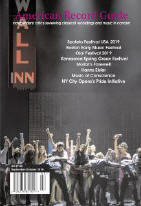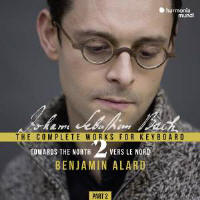Texte paru dans: / Appeared in: Harmonia Mundi |
|
|
Outil de traduction ~ (Très approximatif) |
|
|
Reviewer: Mark
L.Lehman Alard continues his venture to record all of Bach’s organ and harpsichord music in roughly chronological sequence, along with pieces Bach had studied as models. This new volume’s title is “Towards the North”. Bach in his early 20s improved his art by studying the work of master organists: chiefly Bohm (1661-1733), Buxtehude (c1637-1707), Pachelbel (1653-1706), Bruhns (1665-97), and Reincken (c1643-1722). Bach studied briefly with Bohm himself, and some of his older siblings had taken lessons from Pachelbel. Alard plays some representative music by some of these composers (no Bohm or Bruhns). The longest piece is a 19-minute fantasia by Reincken.
For the first two discs, Alard has chosen a Schnitger-styled French organ (built in 2001) with three manuals and interesting tonal colors. The Vallotti temperament of this organ at least matches well enough the required notes of the compositions. There had been serious problems of cacophony in Volume 1 (J/A 2018) when he chose organs with more extreme temperaments, lacking plausible ways to play some of the required notes. The D-major Toccata (S 912a) is here in an earlier version with many surprising differences of harmony and figuration, plus a simpler last section. Alard uses manual 16-foot stops through much of this piece, making a thrilling sound but also causing his fast tempos to drag slightly when the church’s acoustic can’t keep up. As he did with a different piece in Volume 1, Alard again transposes some of Bach’s music (here the Prelude and Fugue, S 566) from E major into C major, and offers no alert or explanation about it. It changes the character of the composition. Peter Wollny’s historical essay in the booklet describes it as in E major, and so do the track lists. I can assert that the piece would have been bright and exotic (but not disastrous) in this organ’s Vallotti temperament, if played in E. In C major it is merely bland most of the time.
This brings us to another
point of questionable historicism: the use of a claviorganum for the next
two discs. It is a small organ (three ranks on this one) mechanically
coupled to a harpsichord. The musician can play them in blended unison or
individually. Alard tries out all of the combinations. He plays a suite by
Reincken that Bach arranged for his own use. It’s a boring composition, but
Alard plays it well and colorfully. There are some short pieces by Buxtehude
and Pachelbel. Bach’s pieces here include two more of the toccatas (S913a
and 914). I haven’t seen evidence that any of these composers, or Bach, ever
played claviorganum. It’s merely a novelty. It gives organ music a more
percussive crunch. The extra moving parts make it less sensitive than a
normal harpsichord in releasing the notes expressively. For Disc 3, my favorite in this box, Alard employs the soprano Gerlinde Samann. She had performed also in Volume 1, singing single stanzas of chorales. In Volume 2 she gets more performance time, taking the cantus firmus in Bach’s longer organ arrangements. There isn’t a historical or liturgical justification offered for this practice, but it is musically effective in communicating the content of the compositions. Samann and the claviorganum sound beautiful in this relatively simple music for organ without pedal. The booklet doesn’t say anything about Alard or Samann. Is Harmonia Mundi assuming that everyone already owns Volume 1, with its interview of Alard about the scope of the project? HM has become skimpy with materials, too—the paper envelopes for the discs are flimsier than the card stock used in Volume 1. HM continues the pattern of putting a different photo of Alard on each envelope and its disc. When he finishes playing all of Bach’s keyboard music for this series, how many photos will that be?
| |
|
|
|
|
Cliquez l'un ou l'autre
bouton pour découvrir bien d'autres critiques de CD |
|




